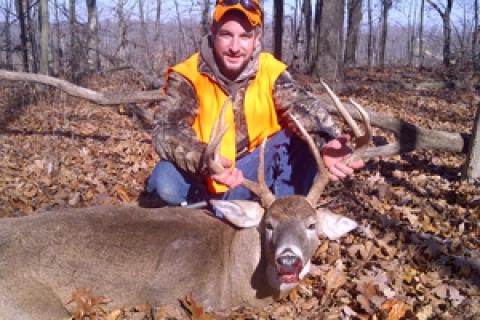
I've been on four guided whitetail hunts in three different midwestern States over the last few years. I bagged a nice buck on two of those hunts, and went home empty handed from the other two. Both of the successful hunts were with outfitters that take a relatively small number of hunters each year, such as Zack's Whitetail Expeditions in southeastern Illinois, while the two unsuccessful hunts were both with high-volume outfitters that play host to hunters numbering in the triple digits each year. Coincidence or cause-and-effect? Are small outfitters inherently a better bet than larger operators? Let's examine the issue.
 |
|
The author's buck and guide from a recent hunt with Zack's Whitetail Expeditions in southeastern Illinois |
Just a Number?
I've heard hunters complain that they've felt like "just a number" when hunting with a larger operation, and that's definitely not what you want. Certainly the chance of getting more personal treatment is greater with a small outfitter, but it's not impossible with a large outfit either. It's simply a matter of having sufficient guides and other staff to ensure that every hunter feels appreciated. There's simply no excuse for poor treatment of customers, no matter the size of the business.
Hunting Pressure
When it comes to the hunting, many hunters think that a large outfitter automatically means heavily-pressured deer, and that's not necessarily the case. For instance, there are outfitters in northern Saskatchewan that operate more than one camp, hunt for 5 or 6 weeks straight, and host 20 or more hunters per week. But the deer the hunters see tend to be lightly pressured simply because these outfitters enjoy a huge hunting territory in big bush. Big outfitter or small, it really boils down to how much land the outfitter has access to relative to the number of hunters. For example, if an outfitter runs 20 hunters a week, that certainly sounds like a lot, and it can be a problem if he has a shortage of land. However, if that outfitter has 10,000 acres to hunt, that translates to 500 acres per hunter. By comparison, if a smaller outfitter only hosts 10 hunters in a given week, which seems like a more intimate operation, but only has 5,000 acres to hunt, it really means the same 500 acres to hunt for each hunter.
The other thing to consider is that even though a particular outfitter may only take a small number of hunters per week in order to keep the hunting pressure low, if all of the neighboring properties are controlled by larger operators that take 200 hunters a year, or are simply hunted hard by locals, the end result is still heavily-pressured deer as the small outfitter will essentially be hunting the same deer.
A Backup Plan?
One thing that I think is important is to make sure, no matter the size of the outfitter that you are considering, that you will have more than one property available to you to hunt. Some outfitters simply assign you a particular farm to hunt for the duration of your hunt and you are pretty much stuck there until the end, even if you are not seeing any deer. I think it's important to have more options than that, as things like a farmer deciding to harvest a crop early, a pack of coyotes invading the property, or a bunch of locals pushing every deer on the property into the next county can really mess up your hunt. Sometimes you also just need a change of scenery, especially on hunts of more than three or four days. Make sure you ask the outfitter about this, and confirm this by checking with the outfitter's references, before you plunk down a deposit.
Personally, I do prefer a small, family-run outfitter, but I won't automatically rule out a larger operator. You simply can't judge a book by its cover, so make sure you ask questions before you go.
Good hunting.
- 2317 views

